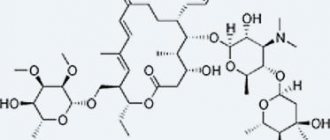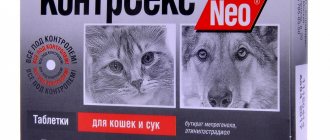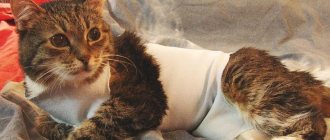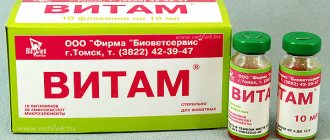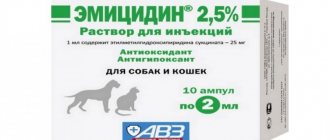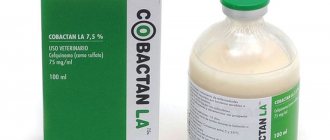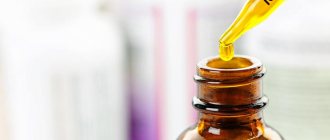general information
The drug is sold in the form of a suspension for injection, which is bottled in 10, 50 or 250 ml bottles. Amoxisan contains the active component - amoxicillin trihydrate, as well as such auxiliary components as:
- highly dispersed synthetic silicon dioxide;
- methylparaben;
- stabilizer E494;
- preservative E216.
The principle of operation of the drug is to suppress the activity of pathogenic transpeptidase enzymes, which are involved in binding the main component of the cell wall of microorganisms - peptidglycan. “Amoxisan” is rightfully considered an antibacterial drug that has a pronounced bactericidal effect, which is aimed at reducing the ability of pathogenic bacteria to develop and multiply, as a result of which it dies. After injection, the maximum content of the active substance is observed after 3-4 hours, and the therapeutic effect continues for 48 hours. Amoxisan leaves the cat's body unchanged along with urine and bile. In terms of danger, the antibiotic is classified as moderately dangerous.
special instructions
It is worth paying special attention to several important points. Firstly, the intravenous use of Amoxicillin is strictly prohibited
Firstly, the intravenous use of Amoxicillin is strictly prohibited.
Secondly, the drug cannot be mixed in the same syringe with any other drug.
Thirdly, the use of the medication cannot be prescribed for the treatment of diseases caused by microorganisms that produce penicillinase.
The fourth point concerns the administration of a drug such as Amoxicillin to a pregnant cat. It is known that penicillins are able to penetrate the placental barrier. However, there is no information about whether they harm the fetus in any way.
Therefore, the use of antibiotics of this type should be approached with the utmost caution, first weigh the pros and cons
How to calculate human?
It happens that you cannot purchase amoxicillin at a veterinary pharmacy. In this case, you have to resort to using an antibiotic intended for humans. It should be remembered that the dosage for humans and dogs is different, so it is necessary to calculate what dose of antibiotic should be given to the animal very carefully.
Knowing that the dosage for treating dogs is 12.5 mg/1 kg of animal body weight, and tablets for humans have a dosage of 250 mg, it can be calculated that for a single dose a dog weighing, for example, 10 kg, you need to give half a tablet of human amoxicillin.
Attention! All calculations are conditional; only a veterinarian can prescribe the exact dosage to avoid accidental overdose.
Negative phenomena
An allergic reaction to the drug may result in severe itching in the animal.
If you strictly follow the veterinarian's recommendations and the manufacturer's instructions, the chance of developing side symptoms is minimal. In exceptional cases, during treatment with Clamoxil, signs of allergy may occur, manifested in the form of redness of the skin, especially at the injection site, swelling and itching. In addition, when studying the medicine, it was noticed that cats with an allergy to it may experience baldness, anaphylactic shock and difficulty breathing. If such negative effects develop, you should stop therapy and consult a veterinarian to find a replacement for Clamoxyl.
Features of application
Amoxisan should not be given to cats if the body is hypersensitive to amoxicillin. Injections are prescribed to pregnant and lactating cats with caution: the negative effect of the antibiotic on offspring has not been fully studied. Therefore, kittens are transferred to artificial feeding during treatment.
The medicine can be prescribed to kittens, but they do not tolerate the pain of injections well, so Amoxisan analogues are more often used in the form of tablets or oral solution.
If the dosage is observed, taking the antibiotic occurs without negative side effects; in rare cases, allergies are possible.
Composition and properties
The main active element is amoxicillin trihydrate, a semi-synthetic antibiotic related to penicillins. The produced form is a solution for injection. Subcutaneous or intramuscular administration of the veterinary drug is used. The highest concentration of the drug in the blood and tissues of the cat is observed 2 hours after the injection. The therapeutic effect can last for 2-3 days. Auxiliary elements:
- aluminum monostearate;
- ethyl oleate
“Amosin” is a dark yellow solution, packaged in glass or plastic bottles of 50, 100 and 250 ml, located in cardboard boxes. The packaging contains instructions for use. When administered "Amosin" there is no irritating effect. This medicine is moderately toxic and well tolerated. Amoxicillin has a prolonged complex effect and affects such types of gram-positive and gram-negative harmful microorganisms as:
With the help of the drug, therapy is carried out when harmful bacteria, such as staphylococcus, enter the body.
- Escherichia coli and hemophilus influenzae;
- salmonella;
- streptococcus;
- listeria;
- staphylococcus;
- clostridia;
- pasteurella;
- Escherichia etc.
Operating principle
When a drug is introduced into a pet’s body, the functional activity of transpeptidases, bacterial enzymes involved in the binding of peptidoglycan (the main component of the cell walls of microorganisms), is suppressed. The elements of the drug have a destructive effect on the cellular system of the bacterium. As a result, the inflammation process is localized and microbes are destroyed. If treatment of the disease is started in a timely manner, the animal’s health is restored without the use of other potent drugs.
Application procedure
According to the instructions for use, Amoxisan is prescribed for medicinal purposes to dogs and other types of animals (cattle, sheep, pigs, cats) for:
- atrophic rhinitis
- inflammation of soft tissues and skin
- inflammatory pathology of the genitourinary system
- infectious diseases of the gastrointestinal tract
- respiratory tract infections
- joint infections
- necrobacteriosis
- primary and secondary infections of bacterial etiology, the pathogens of which are sensitive to the drug
- umbilical infections
- mastitis-metritis-agalactia syndrome
According to the instructions, a contraindication to the use of this veterinary antibiotic is the animal’s hypersensitivity to the components of the drug and antibiotics of the penicillin group, as well as severe dysfunction of the liver and kidneys.
The use of the drug in newborn animals, gerbils, rabbits, hamsters and guinea pigs is prohibited.
Side effects
As a rule, the drug is well tolerated by cats, but sometimes the following may occur:
- allergic manifestations (fever, rhinitis, hyperemia of visible mucous membranes, itching of the skin);
- mild agitation or depression;
- convulsive reactions;
- vomiting and retching, excessive salivation;
- diarrhea;
- distortion of taste and refusal of usual food.
The most common of these are allergic reactions. Since the drug is administered once, special attention is not paid to allergies when prescribing.
The place where the injection was given may react with swelling, which resolves within 1-2 days after injection.
Are there any side effects of Amoxicillin for dogs?
The product is used for otitis media, rhinitis, cystitis, arthritis, gastritis and other serious diseases; a wide range of reasons for use makes you think about what side effects Amoxicillin leads to. If the animal is sensitive to the antibiotic, an allergy may develop. Then you need to quickly stop treatment. Swelling may appear at the injection site for a couple of days. In this case, you need to massage it after administering the injection: this will distribute the active substance in the muscles.
How it works
The drug contains elements that destroy the cellular system of the microorganism. This localizes the inflammatory process and subsequently destroys pathogenic microbes, due to which the cat recovers completely. If the disease is detected in a timely manner, you can do without the use of other medications, including potent drugs.
At the same time, the drug does not lose its properties for a long time. The body “washes away” the chemical composition, but the substance leaves useful substances and components responsible for the active fight against microorganisms. Therefore, even within 48 hours, the minimum dosage preserves the indicated functions and promotes recovery.
shutterstock
You can give the drug to a cat not only because of internal inflammation. This is a universal remedy for owners of “walking” animals. On the street, cats get soft tissue injuries, open wounds and abscesses.
You can administer Amoxoil yourself. A basic set of medical syringes is suitable for this. Timely introduction of the composition will prevent the spread of infection and help the animal quickly rehabilitate after an unsuccessful street fight.
Amoxicillin from Biovet
The Czech-made drug is used in the treatment of diseases of large and small horned animals, pigs, and dogs. Before use, shake the bottle and mix thoroughly. Amoxicillin 15 is administered with a dry syringe 10 cm3/100 kg. A second injection is allowed two days later. Side effects are observed with individual hypersensitivity.
https://youtube.com/watch?v=DDXlfNOuFag
You cannot inject >20 cm3 into one point. The injection site should be thoroughly massaged. If the cow weighs 600 kg, injections should be given at three points.
Sometimes swelling is recorded, which disappears spontaneously 1–2 days after the injection. When identifying signs of personal hypersensitivity, desensitizing agents are used - corticosteroids.
Restrictions
The waiting time for slaughtering cattle is 5 weeks, pigs - 4, milk for food use - 4 days. The previously obtained milk is boiled and fed to animals.
Storage
In proper conditions, in original packaging, at a temperature of 15–25 ° C, the medicine is stored for 24 months. After the first sampling of the contents, the bottle is suitable for use for 28 days.
Amoxylicin
Storage conditions
The shelf life of the drug is 2 years, provided the temperature conditions are observed (from 5 to 25 degrees), storage location (dry, out of direct sunlight), and the bottle is sealed. An opened bottle can be stored for no more than 28 days. After the expiration date, the drug is disposed of in accordance with the law.
Also store the product in the manufacturer's cardboard packaging out of the reach of children and animals, separately from feed and food products.
It is important to take precautions when using the drug. If the product gets on the skin or mucous membranes, wash it off with a stream of running water. If the medicine enters the human body, induce vomiting and consult a doctor
If the medicine enters the human body, induce vomiting and consult a doctor.
Analogs
Analogues of Amoxisan are all drugs based on amoxicillin. Among these are Amosin, Ospamox, Amoxicillin DS, Ecobol, Amoxicillin Sandoz, Flemoxin Solutab.
Amoxicillin: composition, release form and storage conditions
Amoxicillin for cats is produced in Spain. It is a semi-synthetic antibacterial substance belonging to a number of beta-lactam penicillin antibiotics. The role of the active substance in this drug belongs to amoxicillin trihydrate. The medicine is available in 3 forms:
- Liquid for injection, viscous oily suspension of white color. It is packaged in dark glass or plastic bottles. They are sold in volumes of 10, 100, 250 ml. For cats, it is more convenient to use 10 ml bottles.
Amoxicillin in suspension form is the most common form of the drug for animals.
- Powder in plastic containers, metallized plastic bags, craft bags weighing from 50 g to 25 kg, which depends on the purpose of using the drug.
- Tablets packaged in plates (10 pcs.) or plastic jars (24 pcs.). Tablet weight: 0.25, 0.5 g.
Table: composition of the drug by release form
| Component name | Suspension | Powder | Pills |
| Active substance | 15% | 10% | 250 mg/piece |
| Auxiliary components | water | No |
|
The shelf life of Amoxicillin is 3 years from the date of its manufacture. Store the drug in a place protected from light; there should be no cat food or food nearby. The temperature in the room with the medicine should be between 5–25 oC. After opening the bottle of suspension, the medicine can be used for 28 days.
Amoxicillin is produced not only for cats, it is also produced for people. The “human” drug should not be given to animals. The concentration of the active component in it is much higher, and therefore it will be difficult to determine the required amount. If such a need arises, the dosage of the medicine should be calculated by a veterinarian.
Negative phenomena
In some cases, the use of the medicine is accompanied by adverse reactions, such as conjunctivitis.
Amoxicillin is a gentle antibiotic, but, like all antibacterial drugs, it affects not only pathogenic microorganisms, but also beneficial bacteria, causing dysbacteriosis. In addition, while using the medicine, other side symptoms may develop, namely:
- allergic reaction in the form of redness of the injection site, itching, baldness, rash;
- conjunctivitis;
- dermatitis, erythema;
- Quincke's edema;
- urge to vomit;
- severe diarrhea;
- increased nervousness, overexcitement;
- ataxia;
- fungal infections of the oral cavity;
- cardiopalmus;
- dyspnea.
Indications
The drug is prescribed for a variety of diseases. But its most effective use is for diseases of the gastrointestinal tract. These primarily include gastroenteritis, enteritis and enterocolitis. Amoxicillin is no less effective for treating the bronchopulmonary system; in particular, it is prescribed for bronchopneumonia and bronchitis.
This drug is a real salvation for acute diseases of the genitourinary system. Metritis and endometritis, pyelonephritis, cystitis and urethritis are all ailments that, without proper treatment, quickly develop into chronic ones. Amoxicillin is a gentle remedy for quickly getting rid of unpleasant symptoms and their causes. This antibiotic is also widely used as a prophylactic after surgery. This virtually eliminates the development of inflammatory processes.
Amoxicillin is widely used to treat various wounds and abscesses, mastitis, joint inflammation, skin and soft tissue ailments. If the disease is too serious or advanced to be treated only externally, with local means, then this drug will be the best choice.
When to use Amoxicillin
Diseases for which Amoxicillin for cats is used:
- problems associated with disorders in the gastrointestinal tract: enterocolitis;
- gastroenteritis;
- enteritis;
- bronchitis;
- pyelonephritis;
Mastitis in cats (acute inflammatory disease of the mammary gland) is one of the indications for the use of Amoxicillin
This medicine is also used for prophylactic purposes after surgery to prevent the possible occurrence of an inflammatory process.
Instructions for use of Amoxicillin for cats
You can give Amoxicillin to your cat in the form of tablets, powder or injection suspension. The latter is the most convenient and fastest-acting form, but not all owners will be able to give their pet an injection. Then it is better to contact a veterinarian for the dosage, duration of treatment, advice on what to do in case of an overdose.
Pills
Tablets are intended for oral use in cats. They are given with drinking water or milk at a dose of 20–40 mg per kg of animal body weight. To mix into a drink, give 0.2 g (tablet) per half liter of water. If such a dosage is not possible, give the cat a quarter of the tablet with food; you can mix it with wet food or meat or dissolve it with water and pour it into the mouth through a syringe without a needle, holding the animal. The duration of treatment will be 3–5 days.
Powder
Veterinary amoxicillin in powder form is used orally, diluted with water or milk, as in the case of tablets. For cats, 0.5-1 g of the drug with a concentration of 10% per 5 kg of body weight is indicated. The product is given to the animal once a day for 5–7 days. For ease of dosing, it is better to use measuring spoons. It is necessary to ensure that the pet does not receive an overdose, otherwise there is a risk of damage to the respiratory tract.
Amoxicillin injections
An injection suspension of Amoxicillin trihydrate is administered to cats intramuscularly or subcutaneously at a dosage of 0.5 ml per 5 kg or 15 mg per 1 kg. In case of renal failure in an animal, the dose must be measured especially carefully so that the pet does not suffer. Before the injection, the contents of the bottle are shaken to obtain a homogeneous suspension. Injections are given every two days. Afterwards, the treatment site is massaged for better distribution of the substance.
Feedback from cat owners
Cat owners note that the drug is well tolerated by cats.
Petr Nikolaevich. My cat is 9 years old. Two months ago I noticed that she began to sleep a lot, and when she was awake she was lethargic and did not eat well. I took her to the veterinary clinic where she was diagnosed with a bacterial gastrointestinal infection. The specialist prescribed three injections of Amoxisan 0.5 ml intramuscularly, every other day. After two injections, the cat’s condition began to improve noticeably, and after 8 days the cat completely recovered.
Alla Sergeevna. My cat began to lose hair on his right side, at first I thought it was ringworm, or my pet had been picked on by other cats on the street, but at the clinic they told me that it was an infectious skin disease and I needed to give my pet antibiotics. Amoxisan suited me for the price. Since my cat is quite large, the veterinarian prescribed 3 injections of 1 ml every three days and explained to me how to inject the drug. The hair loss stopped around the 10th day, and two months later this area on the side was completely overgrown with beautiful new fur.
Contraindications and side effects
A contraindication for the use of antibacterial agents for cats is individual intolerance to penicillins. You should also stop using antibiotics in the following cases:
- in case of renal failure and serious impairment of kidney function;
- with liver failure.
The doctor makes the decision to use the drug during pregnancy and lactation, as well as for small kittens, individually in each case after weighing all the risks. And although Amoxicillin is considered a safe medicine compared to other antibiotics, in case of overdose it can cause serious problems in the development of offspring.
Note! It is prohibited to combine the use of the medicine with other antibiotics. Swelling may occur at the injection site
It usually goes away on its own within 1-2 days and does not require special treatment. To prevent swelling, after administering the medicinal solution, the injection site should be lightly massaged.
Swelling may occur at the injection site. It usually goes away on its own within 1-2 days and does not require special treatment. To prevent swelling, after administering the medicinal solution, the injection site should be lightly massaged.
If you are intolerant, an allergic reaction may develop. In this case, stop using the medicine. The animal is prescribed glucocorticosteroids and symptomatic treatment. Sometimes the drug causes side effects:
- vomiting;
- diarrhea;
- tachycardia;
- impaired coordination of movements, etc.
The risk of side effects occurs with an overdose. If the above symptoms appear, the use of the drug is discontinued. The animal is prescribed symptomatic treatment.
When using Amoxicillin, dysbiosis may develop and immunity may decrease, so the animal is additionally prescribed vitamin complexes or immunomodulators, as well as products containing lacto- and bifidobacteria to restore intestinal microflora.
Features of antibacterial therapy
Instructions for use
Prescribing Amoxisan for the treatment of cats should be done exclusively by a veterinarian, who will calculate the dosage based on the diagnosis and the condition of the pet.
One of the methods of introducing the drug into the animal’s body is subcutaneous.
Before giving the injection, you need to shake the bottle, the solution is injected subcutaneously or into the muscle. Often, the treatment course includes 2-3 injections with an interval of 36-48 hours. The more precise duration of treatment is determined solely by the veterinarian. The dosage is calculated based on the cat’s body weight - 1 ml of Amoxisan per 10 kg of weight. For small kittens, the dose is three times less than the norm for an adult animal.
When will it be dangerous?
The pharmaceutical drug Amoxisan cannot always be used to treat cats. Thus, the antibiotic is contraindicated in newborn kittens, pets with personal intolerance to its components, as well as in animals with kidney and liver pathologies. Amoxisan therapy should not be combined with other penicillin antibiotics. Pregnant and lactating females are allowed to use the antibacterial drug in question only under the supervision of a veterinarian.
Negative effects
During scientific research, it was revealed that if the dosage of Amoxisan prescribed by the veterinarian is followed, side symptoms and complications in cats are extremely rare. Occasionally, there may be swelling and redness at the injection sites, which disappear on their own within 2 days. In purrs with increased individual sensitivity to penicillin ABs, allergic reactions are observed that require the prescription of antiallergic medications.
Advantages and disadvantages of the drug Clamoxil for cats
Positive properties of Clamoxil:
- It acts quite softly and directed;
- Treatment through injections avoids damage to the cat's stomach and liver;
- Has a rapid bactericidal effect;
- Well distributed in tissues;
- Non-toxic.
Treatment and dosage must be prescribed by a veterinarian, taking into account the individual characteristics of the cat, such as weight, age, general health. In order to relieve the load on the kidneys and liver, hepatoprotective agents are prescribed.
The disadvantages include certain negative manifestations in the pet after taking the drug:
- All biological mass after the death of bacteria is excreted from the cat’s body through the kidneys and liver, increasing the risk of chronic diseases;
- The drug is an antibiotic, and its use leads to the destruction of a large number of beneficial and necessary bacteria for the body;
- There is a factor of individual intolerance to the main component of the drug;
- Allergies associated with taking Clamoxil are possible.
An allergic reaction is expressed by:
- swelling;
- itching;
- baldness;
- rashes on the animal's skin;
- difficulty breathing;
- anaphylactic shock.
If an allergy occurs, you should urgently stop using the medication and replace it with a more gentle medication.
Composition of the drug
The medicine involves a combination of amoxicillin and clavulanic acid. The antibiotic has an antibacterial effect, is well absorbed from the gastrointestinal tract and is excreted from the body by the kidneys. It has a wide range of antibacterial effects and does not contribute to intoxication. The beta-lactamase inhibitor has little effect on the destruction of microbacteria, but together with the antibiotic it promotes the dissolution of microorganisms in the bacterial wall. 1 pill includes 200 mg amoxicillin and 50 mg clavulanic acid.
Amoxicillin for cats characteristics and composition
The drug Amoxoil Retard contains the main active ingredient amoxicillin trihydrate. The same main substance is found in the drug Amoxicillin. This remedy has a wide and complex spectrum of action and is considered quite effective. Capable of providing a prolonged effect. Amoxicillin works well to rid an animal of viral and bacterial diseases.
Amoxicillin trihydrate is classified as a semisynthetic antibiotic. Its characteristics are:
- the drug is administered subcutaneously and intramuscularly;
- the maximum concentration of the drug in the animal’s blood occurs 2 hours after administration;
- the therapeutic effect can last about 2–3 days;
- the drug will not have an irritating effect;
- cats usually tolerate the medication well;
- the drug is moderately toxic.
Amoxicillin has a detrimental effect on a large number of harmful microorganisms.
If we talk about the release form, the drug Amoxoil is sold as a sterile solution for injection in plastic or glass bottles with a capacity of 50, 100 or 250 ml. The solution has a rich dark yellow hue.
Amoxicillin is sold in bottles of 10, 100 or 250 ml. After opening, the bottle should be stored for no more than 28 days according to the recommendations in the instructions for use. Unopened packaging can be stored for no longer than three years.
Analogues of the drug
Amoxisan can be replaced with the following analogues:
- Amokimage. The active ingredient is amoxicillin trihydrate. Its therapeutic characteristics are similar to Amoxisan. The downside is that the drug is packaged in bottles of only 20 or 100 ml; usually a much smaller amount of medicine is required to treat a cat
- Amoxicillin. The treating component is amoxicillin trihydrate. It has a small list of contraindications and side effects that occur extremely rarely.
Analogs
Betamox. ; Northern Ireland (Northern Ireland). Available in the form of a 15% suspension. Belongs to moderately hazardous substances (class 3). The ingredients are: amoxicillin trihydrate (150 mg in 1 ml), butylhydroxyanisole, butylhydroxytoluene, aluminum stearate, fractionated coconut oil. Packaging is carried out in 10 ml bottles, which is very convenient for small animals. After the integrity of the cap is damaged, it is stored for 28 days.
Worthy replacements for Clamoxil are:
"Sinulox RTU". The suspension is produced by the pharmaceutical company Pfizer Animal Health, USA. In addition to amoxicillin, the composition includes clavulanic acid. This component inactivates lactamase, an enzyme produced by the microbial cell and thus protecting itself from the effects of amoxicillin. The spectrum of action of such a complex expands significantly and suppresses the activity of a number of microorganisms. The drug is available in 40 ml and 100 ml bottles, which is much more convenient for use;
"Noroklav". , Great Britain. The drug also has a wider spectrum of action due to clavulanic acid.
The last two taxes are more preferable, since the spectrum of action on microflora is much wider.
general description
Most often, an antibiotic is used for dogs in the form of a suspension intended for intramuscular or subcutaneous injection. The outwardly white liquid is packaged in glass bottles, which are sealed with rubber stoppers and rolled up with aluminum lids to maintain tightness. The composition of the drug is based on amoxicillin in the form of trihydrate. Its concentration in the drug is 150 mg per 1 ml of suspension. It also contains an oily filler. It performs a special role - it ensures the long-term effect of the main component.
Note! You can store the medicine in an opened bottle for no more than 28 days.
The antibacterial agent is also available in the following pharmacological forms:
- Pills. May contain 0.25 and 0.5 g of active ingredient. The tablets are resistant to gastric juice and are quickly absorbed from the gastrointestinal tract.
- Powder for oral administration. The concentration of the active substance is 150 mg of amoxicillin per gram of powder. Packaged in polymer bags of various volumes - from 1 g to 1 kg.
The main active substance amoxicillin is a semisynthetic antibiotic of the penicillin series. Its main advantage is its wide spectrum of action. The drug is active against various gram-positive and gram-negative bacteria. These include:
- streptococci;
- staphylococci;
- salmonella;
- enterobacter;
- pseudomonas;
- erysipeloids;
- pasteurella;
- listeria, etc.
A complete list of bacteria against which Amoxicillin is effective when used in dogs can be read in the instructions included with the medication.
When is Amoxoil used?
The medicine is prescribed not only to dogs or cats, but also to cattle, sheep and pigs. This is a remedy that helps in the treatment of pneumonia, respiratory diseases and ailments that relate to inflammation of the elements of the genitourinary system.
shutterstock
Amoxoil should be used in the treatment of cats according to the recommendations of doctors and manufacturers:
The drug is administered intramuscularly, an alternative method is subcutaneous. It all depends on the condition and endurance of the cat’s body. The dose is calculated according to the pet's weight. On average, no more than 1 ml of amoxoil retard la is calculated per 10 kg. Doses are not administered continuously or daily. The minimum waiting time is 48 hours, after which the medication is continued. The basic dosage is suitable for animals that have not previously had stomach problems. If renal failure is observed, the volume of the drug is selected according to individual tolerance. The substance is first prepared. To do this, the bottle with the composition is shaken, due to which the retard turns into a homogeneous mixture. Instruments are washed in advance, otherwise it is easy to introduce infection. The substance is administered through dry syringes and needles. When the dose exceeds 20 ml, the total volume is divided into several injections
It is important that doses were administered at different points and with certain breaks, so as not to oversaturate the body with the medicine.
After administering Amoxoil, you can massage the injection site. This will reduce pain and calm your pet. For a cat, any interaction with third-party medications is an unpleasant procedure.
The drug cannot be used in all cases. Manufacturers identify a number of contraindications:
- Individual intolerance. It is recommended to visit your pet's doctor. Due to natural predisposition and previous illnesses, the cat may not be able to withstand some of the components of the medicine.
- The manufacturer's indication excludes interaction with other antibiotics and antibacterial agents. These are mainly antibiotics of the penicillin class.
- If the kidneys and liver are damaged, Amoxoil is dangerous and harmful. The use of medication can cause a sharp deterioration in the cat's health and lead to complications.
Kittens should not be involved in the use of Amoxoil Retard. This is a preventive remedy that is aimed exclusively at adults and elderly individuals without side diseases.
shutterstock
Amoxisan Api-San
Packaging 10 / 100 mlAMOXISAN Amoxicillin (amoxicillin trihydrate) TRADE NAME OF THE DRUG AMOXISAN / AMOXISAN DOSAGE FORM Suspension for injection. COMPOSITION AND RELEASE FORM Amoxicillin trihydrate – 150 mg/ml, auxiliary components. The drug is available in 10 ml, 100 ml glass bottles, packaged individually in cardboard packs along with instructions for use. PHARMACOTHERAPEUTIC GROUP Antibacterial agent. PHARMACOLOGICAL PROPERTIES Amoxicillin trihydrate, which is part of the drug, is a semi-synthetic antibiotic of the penicillin series, active against gram-positive and gram-negative microorganisms, including Actynomycesspp., Bacillusantracis, Clostridiumspp., Corynebacteriumspp., Erysipelothrixrhusiopathiae, Listeriamonocytogenes, Staphylococcusspp., Streptococcusspp., Actinobacillusspp., Escherichiacoli, Salmonellaspp., Fusobacteriumspp., Haemophilusspp., Moraxellas pp., Pasteurellaspp., Proteusmirabilis, Leptospiraspp. The mechanism of the bactericidal action of the antibiotic is the ability to inhibit the biosynthesis of the cell wall of microorganisms, which leads to its death. After intramuscular administration of Amoxisan, the maximum concentration of amoxicillin trihydrate in the blood serum is achieved within 1-2 hours and is maintained at a therapeutic level for 48 hours. The antibiotic is excreted from the body mainly with urine and partially with bile, mainly in unchanged form. In terms of the degree of impact on the body, Amoxisan belongs to moderately hazardous substances (hazard class 3 according to GOST 12.1.007-76). INDICATIONS FOR USE Amoxisan is prescribed for medicinal purposes to cattle, sheep, pigs, dogs and cats for infectious diseases of the gastrointestinal tract , respiratory tract, genitourinary system, joints, soft tissues and skin, necrobacteriosis, umbilical infections, atrophic rhinitis, mastitis-metritis-agalactia syndrome and other primary and secondary infections of bacterial etiology, the pathogens of which are sensitive to amoxicillin. CONTRAINDICATIONS A contraindication to the use of Amoxisan is the increased individual sensitivity of the animal to the components of the drug. Do not exceed the recommended volume of administration of the drug to an animal in one place. METHOD OF APPLICATION AND DOSES Amoxisan is administered to animals subcutaneously or intramuscularly at a dose of 1 ml per 10 kg of animal weight (15 mg of active substance per 1 kg of animal weight), if necessary, the injection is repeated after 48 hours. The suspension should be shaken thoroughly before use. The maximum volume of Amoxisan for administration to an animal in one place should not exceed 20 ml. SIDE EFFECTS When using Amoxisan in accordance with these instructions, side effects and complications, as a rule, are not observed. In rare cases, the animal may develop edema at the injection site, which resolves spontaneously within 1-2 days. OVERDOSE In case of overdose or increased individual sensitivity of the animal to the components of the drug and the appearance of side effects (refusal of food, vomiting, loss of coordination of movements), the use of Amoxisan is stopped and desensitizing therapy is carried out. SPECIAL INSTRUCTIONS Slaughter of animals for meat is permitted no earlier than 28 days after the last use of Amoxisan. The meat of animals forcedly killed before the expiration of the specified period can be used as feed for fur-bearing animals. Milk from dairy animals is allowed to be used for food purposes, no earlier than 96 hours after the last administration of the drug. Milk obtained earlier than the established period can be used after boiling in animal feed. INTERACTIONS WITH OTHER MEDICINES Amoxisan should not be used simultaneously with thiamphenicol, chloramphenicol, penicillin antibiotics, cephalosporins and fluoroquinolones, or mixed in the same syringe with other drugs. STORAGE CONDITIONS In sealed manufacturer's packaging, separate from food and feed, in a dry place, protected from light, at a temperature of 5 to 25 ° C. The medicine should be stored in places inaccessible to children and animals. SHELF LIFE Subject to storage conditions - 2 years from the date of manufacture, after opening the bottle - no more than 28 days. Do not use the drug after the expiration date.
Read/leave a review about the veterinary drug Amoxisan
Pharmacological properties
Amoxisan is a veterinary antibacterial drug of the penicillin series.
Amoxicillin trihydrate, which is part of the drug, is effective against animal pathologies caused by microorganisms:
- Actinobacillus spp.
- Actynomyces spp.
- Bacillus anthracis
- Clostridium spp.
- Corynebacterium spp.
- Erysipelothrix rhusiopathiae
- Escherichia coli
- Fusobacterium spp.
- Haemophilus spp.
- Leptospira spp.
- Listeria monocytogenes
- Moraxella spp.
- Pasteurella spp.
- Proteus mirabilis, Salmonella spp., Staphylococcus spp., Streptococcus spp.
The mechanism of the antibacterial action of amoxisan is to suppress the functional activity of bacterial trans peptidase enzymes involved in binding the main component of the cell wall of microorganisms that cause infections in animals - peptidglycan.
The veterinary drug amoxisan is easily absorbed from the injection site and penetrates into most organs and tissues of dogs and other animals. The maximum concentration of the antibiotic in the blood is observed after 1-2 hours and is maintained at a therapeutic level for at least 48 hours after parenteral administration of the drug.
The drug is excreted from the body of dogs and other animal species mainly in unchanged form, mainly with urine, to a lesser extent with bile, and in lactating animals - partially with milk.
CLINICAL PHARMACOLOGY: Amoxisan diffuses readily into most of the body, tissues and fluids in animals with the exception of the brain and cerebrospinal fluid, except in cases of inflammation of the meninges. Most of the amoxicillin from the animal’s body is excreted unchanged from the urine. Amoxicillin is similar to ampicillin in its bactericidal action against susceptible organisms. It acts by inhibiting the biosynthesis of cell wall mucopeptide. In vitro and/or in vivo studies have demonstrated the susceptibility of most strains of the following gram-positive and gram-negative bacteria:
- a- and b-hemolytic streptococci
- non-penicillinase-producing staphylococci
- Streptococcus faecalis
- Escherichia coli
- Proteus mirabilis
According to the degree of impact on the body, amoxisan is classified as a moderately hazardous substance
(class 3 according to GOST 12.1.007-76), well tolerated in recommended doses, does not have teratogenic, embryotoxic and hepatotoxic properties.
Purpose
Amoxicillin is prescribed for infectious lesions of the following systems and organs:
- Nutritional. The drug successfully copes with bacteria that cause inflammation of the stomach, large and small intestines.
- Respiratory. Amoxicillin 15 is used for rhinitis and bronchopneumonia.
- Urogenital. The drug is prescribed for endometritis, cystitis, pyelonephritis.
- Skin, soft textures - with pyoderma, agalactia, mastitis, MMA.
The drug is also prescribed for the treatment of infectious pathologies:
- Leptospirosis.
- Pasteurellosis.
- Pig faces.
- Actinomycosis.
- Paratyphoid.
- Necrobacteriosis of cattle and small ruminants.
Amoxicillin is effective against necrobacteriosis
Adverse reactions
The use of the drug may cause negative reactions, such as loss of appetite and vomiting.
If the therapeutic dose is strictly followed, adverse reactions are unlikely. If the dosage is exceeded, there is no intoxication. In some situations, cats may experience an allergic reaction after using Amosin. It can be eliminated with the help of adrenaline, corticosteroids and other antihistamines. Sometimes, with an overdose, symptoms such as:
- oppression;
- dysfunction of the gastrointestinal tract;
- swelling at the injection site;
- poor appetite;
- vomit;
- impaired coordination of movements.

